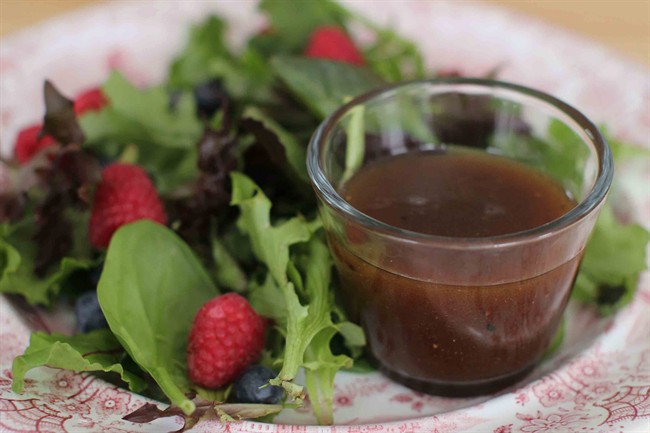Most people reach for prepared salad dressings because on busy weeknights they just can’t handle the thought of whipping up yet something else. Because after cooking a main course and some sides and tossing together a salad, who has the time and energy to make a dressing?

I get it. It’s convenient. But homemade dressings are so much better, they really are worth the trouble. Homemade dressings not only are fresher and taste better, they also are better for you. The good news is that making dressing doesn’t have to be a daily chore. In just five minutes you can prep one big batch of dressing for the entire week.
So let’s walk through the basics of vinaigrettes.
The standard recipe for a vinegar-based dressing calls for a 3-to-1 ratio of oil to vinegar (or other acid). But really that’s just a starting point. Years ago when I was teaching a class in basic techniques, I tested the validity of that ratio by asking my students to make dressings of their own. All of them used olive oil, but each one picked a different acid.
That was an eye-opener! Three tablespoons of oil swamped rice vinegar, but barely balanced the acidity of sherry vinegar. Bottom line: The acid content in vinegars can vary widely, so you’ll want to adjust for that.
What about the oil? Mostly, I opt for good quality extra-virgin olive oil. You want to break out the good stuff because you’re really going to taste it in a dressing. But if you don’t like the taste of olive oil, you can use an oil with a more neutral flavour, such as grapeseed (though it’s pricey). Safflower and sunflower are less expensive and also are perfectly acceptable.
- B.C. to ban drug use in all public places in major overhaul of decriminalization
- Posters promoting ‘Steal From Loblaws Day’ are circulating. How did we get here?
- 3 women diagnosed with HIV after ‘vampire facials’ at unlicensed U.S. spa
- Canadian food banks are on the brink: ‘This is not a sustainable situation’
Nut oils are another way to go, including walnut and hazelnut, as well as two of my favourites: pistachio and pumpkinseed. They pair up very well with fruit vinegars, such as raspberry.
What are the best ways to mix a vinaigrette?
The easiest include measuring and mixing it in a glass measuring cup, shaking it in a jar (an almost empty mustard jar is a good choice), or briefly whizzing it up in a blender. And I say briefly about the blender because too much whizzing may make olive oil taste bitter.
Start with the acid, salt and pepper, and mix them until the salt is dissolved. Then, if you’re using a measuring cup, add the oil slowly in a stream, whisking until it’s incorporated. If you’re mixing it in a jar, add all of the oil and shake. If you’re using a blender, add the oil and pulse until well combined.
A vinaigrette is a temporary emulsion, meaning that when you whisk or shake it, the oil and vinegar will combine long enough to coat your salad. Eventually, though, these components will separate again. You can make the dressing stay together longer by adding an emulsifier, such as mustard or an egg. I prefer mustard, not only because of its power to emulsify, but because I really like its taste.
Tasty add-ins?
Your choice: minced shallots (which contribute a pleasantly sweet crunch), a minced clove of garlic, chopped fresh herbs, a bit of soy sauce or miso, crumbled cheese, grated fresh citrus zest or capers.
Want to cut down the vinaigrette’s calorie count?
Cut down the amount of oil. Depending on my mood, I’ll swap in chicken broth, pureed fresh tomato or roasted red pepper, or pureed (very ripe) pear, all of which contribute flavour and body. Sugar, too, can replace oil, which is why relatively sweet balsamic vinegar requires relatively less oil for balance in a vinaigrette. But I ‘m not a fan of sugar in dressings. We already eat way too much.
By the way, there’s no reason to confine vinaigrettes to the salad bar. They can perk up grilled vegetables, chicken or steak, and they partner up beautifully with fish.
—
BASIC VINAIGRETTE
Start to finish: 5 minutes
Makes 1 cup
- 1/4 cup acid (see choices below)
- 2 teaspoons kosher salt
- 2 teaspoons Dijon mustard
- 1/2 teaspoon ground black pepper
- 3/4 cup oil
In a 1-cup measuring cup or screw-top jar, combine the acid, salt, mustard and pepper. Whisk (or cover and shake if using a jar) until the salt is dissolved. Add the oil in a steam while whisking (or add the oil all at once and shake if using a jar). Store in the refrigerator. Let the vinaigrette come to room temperature before using.
Nutrition information per tablespoon: 90 calories; 90 calories from fat (100 per cent of total calories); 10 g fat (1.5 g saturated; 0 g trans fats); 0 mg cholesterol; 0 g carbohydrate; 0 g fiber; 0 g sugar; 0 g protein; 260 mg sodium.
—
ACID SUGGESTIONS (listed from most to least acidic):
- Sherry vinegar
- Red wine vinegar
- Balsamic vinegar
- White wine and Champagne vinegars
- Cider vinegar
- Rice vinegar
- Raspberry vinegar
- Fresh lemon, lime, orange or grapefruit juice


Comments